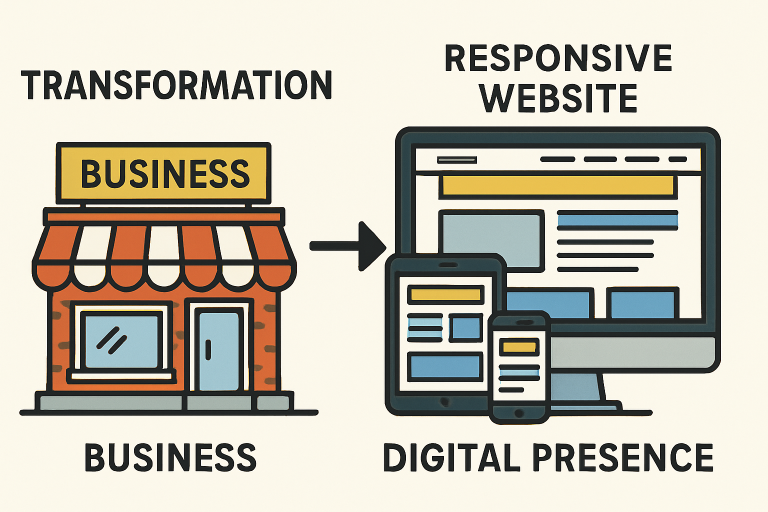
Introduction
In today’s hyper-connected world, a business’s digital identity often starts and ends with its website. Serving as a virtual storefront, a strong website design not only attracts attention but also sets the tone for customer engagement and company reputation. Whether you’re a small startup or a global enterprise, your website is usually the first contact point for prospects and clients alike.
Research shows that consumers make split-second decisions about a business’s credibility based primarily on how its site looks and functions. With market competition fiercer than ever, the way a business presents itself digitally can either invite customers in or drive them elsewhere. As companies invest more resources into developing robust online strategies, the need for visually compelling, user-centric websites has never been greater.
Yet, the impact of strong website design goes beyond surface-level impressions. The right design choices affect not just aesthetics, but also ease of use, conversion rates, and long-term brand loyalty. As digital marketing continues to evolve, skilled designers hold the key to unlocking business growth by aligning creative vision with user needs and technical requirements.
First Impressions Matter
The significance of first impressions cannot be overstated in the online environment. According to a study, 75% of users admit to making judgments about a company’s credibility based solely on website appearance. Outdated layouts, poor navigation, and clashing colors can send potential customers bouncing away instantly. Professional website designers play a crucial role in preventing this by crafting visually appealing, user-friendly interfaces that reflect a brand’s identity and values. A polished and intuitive design communicates trustworthiness, relevance, and attention to detail in just seconds.
This psychological response occurs quickly, sometimes in less than 0.05 seconds, meaning a sleek design forms an almost immediate perception of quality. Companies ignore this at their peril, as negative first impressions are hard to overcome, even with outstanding products or services.
User Experience and Conversion Rates
User experience (UX) lies at the core of effective website design. A seamless journey—characterized by easy navigation, quick-loading pages, and precise calls to action—can dramatically increase the likelihood that visitors will take the next step, whether it’s making a purchase or booking an appointment. Statistics confirm that intuitive interfaces can increase conversion rates by up to 200%, with exceptional UX driving potential gains as high as 400%. Features such as strategic button placement, readable fonts, and logically organized content help visitors find what they need more quickly, increasing the likelihood of conversion.
Mobile Optimization
Mobile browsing has overtaken traditional desktop access to become the dominant way people experience websites. Over 70% of web traffic now originates from smartphones and tablets, making mobile optimization non-negotiable for any business serious about growth. Responsive design, which adapts layouts to all screen sizes, is critical to enhancing the user experience across devices.
According to Business News Daily, Google’s mobile-first indexing and ranking algorithms make it essential for companies to prioritize mobile performance to stay visible in search results. Businesses that neglect this aspect risk losing valuable visibility and customer engagement opportunities.
Companies that invest in responsive designs enjoy a 25% surge in lead generation and sales compared to those with desktop-only sites. This effect is powerful in sectors that rely on local or impulse-driven purchases, such as retail and hospitality.
Search Engine Optimization (SEO)
SEO and website design are deeply interconnected. Clean, fast-loading pages with well-structured HTML not only appeal to users but also to search engines. According to Search Engine Journal, search algorithms favor sites where technical and design aspects work harmoniously, with fast performance, mobile readiness, and meaningful content all playing a role.
Good design makes it easier to implement foundational SEO strategies, such as strategic keyword placement, logical site architecture, and effective meta tagging. Sites that follow these best practices can see organic traffic gains of up to 50%.
Brand Consistency and Recognition
Consistent branding is the foundation of lasting customer relationships. Every visual element on a website should align with the business’s identity—from colors, logos, and typefaces down to the style of imagery and voice of written content. A study found that organizations with consistent brand presentations are three to four times more likely to enjoy excellent brand visibility than those with inconsistent brand presentations.
Clear, recognizable branding builds trust by reinforcing the values and promises a business makes to its audience, making it more likely that customers will return and recommend the brand to others.
Competitive Advantage
Businesses with cutting-edge, user-focused website designs consistently outperform their competition. A visually appealing, high-performing website not only draws visitors in but also encourages them to stay, explore, and ultimately make a purchase or submit an inquiry. Companies leading in web design report revenue growth rates up to 32% faster than those with lackluster sites.
The ability to differentiate through design drives stronger customer connections and leads to repeat business. In saturated markets, an innovative approach to web presence becomes a critical differentiator.
Conclusion
Investing in strong website design is far more than visual appeal—it’s a strategic lever for long-term business growth. From building trust at first glance to supporting SEO and conversion goals, every aspect of a company’s web presence contributes to its market success. Skilled website designers are the architects of this digital transformation, bridging creative vision with technical excellence to drive measurable business outcomes. By prioritizing high-quality web design, businesses can position themselves for enduring relevance and sustainable growth.